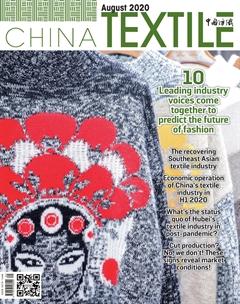Analysis on the transfer trend of global textile and apparel industry chain
by Zhao Xinhua

In recent years, the global textile and apparel trade trend has changed. As the largest textile and apparel exporter, China occupies an important position in the industrial chain. Due to changes in international relations and the rise of textile and apparel industry chains in Vietnam, Bangladesh, India and other countries, international textile and apparel trade has shifted. Chinas textile and apparel exports share has begun to decline in some regions. Here we select China, the European Union, the United States, and Japan as the research targets, and analyze the changes in Chinas textile and apparel exports and changes in imports from the European Union, the United States, and Japan in the past 10 years. The European Union, the United States, and Japan are Chinas largest export destinations of textiles and apparel, and they are also important links in the global textile and apparel trade. Selecting them as research objects can more intuitively show the changing trend of the global textile and apparel industry chain.
China textile and apparel exports
Textile exports: The European Union, the United States and Vietnam account for the main share, and Vietnams share has increased significantly in 10 years.
In 2019, the main export destinations of Chinese textiles were the European Union, the United States, Vietnam, Bangladesh, Japan, China Hong Kong, and Indonesia. Among them, Chinas textile exports to the European Union, the United States and Vietnam accounted for more than 10%, and respectively 11%, 10.4% and 10.2%, Bangladesh accounted for 5.4%, Japan accounted for 3.8%, China Hong Kong accounted for 3.6%, and Indonesia accounted for 3.5%. Chinas textile exports to the United States fell 9% year-on-year in 2019, exports to Bangladesh also fell 4.6% year-on-year, while Vietnams exports increased by 4% year-on-year.
By comparing the data of 2009 and 2019, it can be found that the proportion of Chinas textile exports to the EU and the United States has not changed much in the past 10 years. The proportion of textile exports to China Hong Kong has declined significantly, with a decrease of 8%. The proportion of Vietnams exports has increased by 6.5% in 10 years, from 3.7% in 2009 to 10.2% in 2019.
Apparel exports: The share of apparel exports to the EU and Japan has declined significantly in 10 years.
In 2019, the main export destinations of Chinese apparel were the European Union, the United States and Japan, accounting for 22.4%, 21.6% and 10% respectively. In 2019, Chinas apparel export value fell 4% year-onyear, and Chinas apparel export value to the EU, the United States and Japan all declined year-on-year, with the United States experiencing the largest decline.
U.S. textile and apparel imports
In 2019, the total U.S. textile and apparel imports were USD 111.2 billion, of which apparel imports were USD 83.8 billion and textile imports were USD 27.4 billion. The ratio of the two was 3:1.
Textile imports: China has the largest share, but the share has not changed much in the past 10 years, while Indias has slowly increased.
According to statistics from the Office of Textiles and Apparel (OXTEA), from 2009 to 2019, U.S. textile imports showed an overall growth trend. Except for the year-onyear decline in textile imports in 2016 and 2019, textile imports in other years is increasing year by year. In 2019, U.S. textile imports increased by 53% compared to 2009.
From the perspective of the textile import market, the main source of imports is China, which accounted for 42% in 2019, followed by India with 14.6%, and the European Union ranked third with 8.5%. Among them, China has been the largest source of textile imports for the United States since 2009. In the past 10 years, the value of textile imports from China by the United States has basically the same trend as the value of textile imports from the world, and the proportion of textile imports from China has basically remained at 40% - 50%. In 2019, the proportion fell by 4.9% year-on-year, and the reason was related to the SinoUS trade friction. The second source country of U.S. textile imports, India, accounted for only 9.2%, which is lower than the EU. However, the value of U.S. textile imports from India has increased year by year over the past 10 years, and the proportion is also increasing; although the EU accounted for 14% in 2009, second only to China, but in 2011, the ratio fell by 6% year-on-year, and has remained at 7.5% - 8.5% since then.
Apparel imports: The rise of Vietnam to squeeze Chinas export share.
The value of U.S. apparel imports has also shown an overall upward trend in the past 10 years. In 2019, U.S. apparel imports were USD 83.8 billion, an increase of 32.8% from 2009s USD 63.1 billion.
From the perspective of apparel import source countries, the top 5 countries are China, Vietnam, Bangladesh, Indonesia, and India. In 2019, the United States apparel imports from these countries accounted for 29.7%, 16.2%, 7.1%, 5.3% and 4.9%, respectively. Among them, the proportion of China and Vietnams imports in the past 10 years has shown obvious changes in the opposite direction. The import value of apparel from China of the United States first increased and then decreased. In 2019, the amount of apparel imports only increased by USD 1.4 billion compared with 10 years ago, and the proportion showed an overall downward trend. The proportion in 2019 decreased by 6.9% compared with 36.6% in 2009, while the U.S. apparel imports from Vietnam steadily increased year by year. In 2019, the value of apparel imports increased by USD 8.5 billion compared with 10 years ago, an increase of 1.67 times. The ratio is also increasing year by year, an increase of 8.3 percentage points from 10 years ago.
It can be seen that in the past 10 years, Vietnams garment industry has continued to grow, with output and exports increasing year by year. To a certain extent, Vietnam, as an emerging garment production and exporting country, has a competitive relationship with China and seizes the share of Chinese apparel exports. In 2019, this situation was even more obvious. The proportion of U.S. apparel imports from China fell by 3.3% yearon-year, and Vietnam increased by 1.43% year-on-year. The growth rates of them in 2019 were the largest in 10 years. Due to the United States imposing tariffs on textiles and apparel, and U.S. apparel downstream companies have reduced their imports of Chinese apparel and instead increased their imports of apparel from Vietnam. In terms of other importing countries, Bangladesh, Indonesia, and India have all increased their apparel exports to the United States year by year in the past 10 years, but the curve is much flatter than Vietnam. In terms of proportion, only Bangladesh has overall growth, with an increase of 1.75% in 2019 compared with 10 years ago. Indonesias share first increased and then decreased, with little overall fluctuations, while Indias share did not fluctuate significantly in 10 years.
EU textile and apparel imports
Textile imports: Chinas share is in the overall rising trend.
In 2019, EU textile imports amounted to 28.1 billion Euros, an increase of 86% compared to 2009. From the perspective of the textile import market, the main source of imports is China, which accounted for 38% in 2019, followed by Turkey with 14.6%, and India with 8.2%, ranking third. From the perspective of textile imports, China, Turkey, and Indias textile exports to the EU have all increased in 10 years, with Chinas largest increase of 129%, followed by Turkey with 71% and Indias 52%. From the perspective of the proportion of textile imports, Chinas overall proportion has shown a clear upward trend. The proportion in 2019 has increased by 7 percentage points compared with 2009, while the proportion of Turkey has decreased by 1.35 percentage points compared with 10 years ago. It showed a slow downward trend, a decrease of 1.84 percentage points from 10 years ago. Apparel imports: Bangladesh seizes Chinas share of EU apparel exports.
In 2019, the value of EU apparel imports was 88 billion euros, an increase of 53% compared to 2009. From the perspective of the apparel import market, the top 6 source countries in 2019 were China, Bangladesh, Turkey, India, Cambodia and Vietnam. The proportions in 2019 were 30.5%, 20%, 11.6%, 5.7%, 4.6% and 4.2%.
From the perspective of the amount of apparel imports, the EUs imports of Chinese apparel have basically maintained at USD 25 - 30 billion in 10 years. The amount of imports in 2019 has not changed much since 2009; the EUs imports of apparel from Bangladesh show obvious changes, with an increase of 241% in 10 years; the increase of the European Unions apparel imports from Turkey has increased slowly by 44% in the past 10 years; the EUs apparel imports from India have basically remained at 4.1 billion to 5.2 billion euros in the past 10 years, an increase of 21%; Cambodia and Vietnams apparel exports to the EU have slowly increased over the past 10 years, with Cambodia increasing from 600 million euros to 4 billion euros, and Vietnam from 1.2 billion euros to 3.7 billion euros.
From the perspective of the proportion of apparel imports, Chinas proportion has shown a clear downward trend. The proportion in 2019 decreased by 14% compared with 2009; due to the rapid growth of the EUs apparel imports to Bangladesh in 10 years, its share increased by 11% compared with 10 years ago; Turkeys overall share has not changed much; Indias share in 2019 has fallen by 1.47% compared with 10 years ago; Cambodia and Vietnams apparel exports to the EU have slowly increased in proportion, increasing by 3.6 percentage points and 2.1 percentage points.
Japan textile and apparel imports
Textile imports: China accounts for the largest share but declines year by year, Vietnam increases year by year.
In 2019, Japans textile imports amounted to USD 907 million, an increase of 55% compared to 2009. From the perspective of the textile import market, China is Japans largest source of textile imports, accounting for 54%. The proportion of textiles imported by Japan from other countries is very different from China, all of which are below 10%. Japans textile imports to China have also shown an increasing trend in the past 10 years. In 2019, compared with the value of 2009, it increased by 31% year-on-year. Although the volume of Chinese textile exports to Japan is very large, we can see some different things by observing the change of import proportion in the past 10 years. Japans share of Chinas textile imports has shown a significant decline in the past 10 years, with a drop of nearly 10%, while Vietnams share has increased from 2.7% in 2009 to 9.3% in 2019.
Apparel imports: Chinas share decreased by 27% in ten years, and Vietnams share increased by 11%.
Similar to the distribution of textile imports, Japans main source of apparel imports is also China, accounting for 56.8%. In the past 10 years, Japans apparel imports from China have shown an overall upward trend. The value in 2019 has fallen by 8% compared with 10 years ago. From the perspective of the proportion trend, Japans ap- parel imports from China have shown a very smooth downward trend. In 2019, the proportion decreased by 27% compared with 2009. Vietnam, as the second source country of Japanese apparel imports, Japans apparel imports value has increased by 401% in 10 years, and its proportion has steadily increased, reaching 11% in 10 years.
Through research, it is found that the global textile and apparel trade trend has undergone significant changes in the past 10 years. As a traditional textile and apparel exporting country, Chinas export proportion has begun to decline, while the proportion of textile and apparel exports in emerging countries such as Vietnam and Bangladesh have appeared obvious increase.
In terms of apparel, Chinas main export destinations are the European Union, the United States and Japan. In 2019, Chinas apparel exports to the European Union and Japan dropped significantly compared to 10 years ago, and Chinas apparel exports to the United States increased compared to 10 years ago. In terms of different countries, the U.S.s share of Chinese apparel imports fell by 6.9% in 10 years. At the same time, its share of Vietnamese apparel imports increased by 8.3%. The EUs share of imports from China has fallen by 14% in 10 years. At the same time, its share of apparel imports from Bangladesh has increased by 11%; Japans share of Chinas apparel imports has fallen by 27% in 10 years. At the same time, its proportion of Vietnamese apparel imports increased by 11%. It can be seen that the apparel production and export industries in Vietnam, Bangladesh and other countries have gradually grown in 10 years, competing with the traditional garment exporting country, China, squeezing the export market, and the garment industry chain is shifting.
In terms of textiles, Chinas main export destinations are the European Union, the United States and Vietnam. The share of Europe and the United States is basically the same as 10 years ago, but Vietnams share has increased significantly compared to 10 years ago. In terms of different countries, China accounts for the largest share of U.S. textile imports at 42%. The total amount of imports has increased in 10 years, but the proportion has not changed much. The proportion of India, the second source of import, increased slowly. It is not ruled out that Chinas share will be occupied by other emerging textile export destinations in the future. Chinas textile imports in the EU also accounted for the largest share of 38%. Both the value and the proportion of imports have been on the rise in 10 years. Vietnams textile imports from China have increased significantly in the past 10 years. This is due to the gradual expansion of Vietnams garment production and export industries in recent years, but its textile industry chain is not complete and needs to be met by imports.
- China Textile的其它文章
- Dear readers
- 10 Leading industry voices come together to predict the future of fashion
- The recovering Southeast Asian textile industry
- 97 percent Bangladeshi products to get duty-free access to China,and India to lose its competitive advantage
- Vietnam market demand will resume,but the whole year exports may fall
- How about the textile and apparel industry in Cambodia,Myanmar,Laos and Thailand in the first half of the year?

